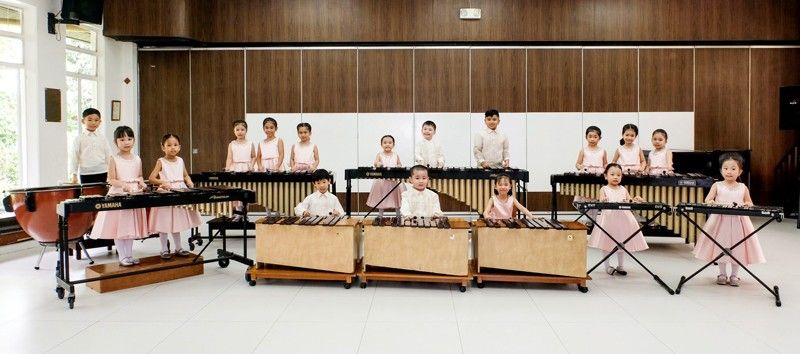Philippine Montessori kids play their way to Carnegie Hall


It was a hot May afternoon and I was surrounded by preschoolers telling me they’d rather play Mozart than go swimming.
We’re on a porch by the garden, inside the Philippine Montessori Center, a lovely, homey place to strike the drum snare, hammer the xylophone, and make some music. Apparently, this has been the children’s routine for some time now — five to six days a week, from 11 to 1 p.m. — and it will be until this small ensemble flies to New York for a grand performance on May 31 at Carnegie Hall.
The Philippine Montessori Center Instrumental Ensemble (PMCIE), which was started in the early 1980s, now has 17 members aged four to six. Some were quiet, others restless, but every single one knew how to sustain a beat. When we met, they were fresh from their send-off concert held at the Meralco Theater last May 3. Their “Pinoys to the World” concert series now culminates at Carnegie, where they will be performing alongside the soprano duo The Nightingales.
“What makes you most excited about Carnegie Hall?” asks their music teacher Lois Espinosa, who has been with the school for 34 years.
Santi, one of the young performers, answered eagerly, “Because the best musicians came (and played) there.”
Espinosa explains that this performance was upon the invitation of the Children’s Orchestra Society in New York, a non-profit organization whose conductor, Michael Dadap, also happened to be Espinosa’s uncle. All stars have aligned for the talented younglings. In this particular rehearsal, their music teachers Garche Tura-Crodua and Bethel Batayo are both their audience and co-musicians; Catherine Zulueta takes her place by the piano to provide the melody; and Espinosa, leading the ensemble, tap-tap-taps her two sticks for a sustained metronomic beat.
“It’s like sports,” Zulueta tells me. “To be able to get to a goal, everybody has to work.”
Or in the case of this troupe, everybody has to play.

PMCIE music teachers Catherine Zulueta, Garche Tura-Crodua, Bethel Batayo, and Lois Espinosa
Their lineup of pieces covers a wide range from classical to Broadway, from the fast-paced contemporary Sabre Dance to Ernani Cuenco and Levi Celerio’s Kalesa. It seems that this vast and varied selection also aims to amuse the audience with familiar tunes — like the ever nostalgia-inducing Sound of Music set from Do-Re-Mi to My Favorite Things — but for the teachers, it’s much more than entertainment.
“I wanted to educate the parents also,” says Espinosa. “It’s not just for the arts, but for the discipline.”
Mozart’s Symphony No. 40 in G Minor — with its playful, riveting rhythm that makes me think of little feet running or pebbles lightly skipping on water — is clearly the children’s favorite. For those of us who didn’t go to conservatories, Mozart may be less of a draw than your more popular Romantics. For these kids, however, “It gets to a point that they love classical, they understand, they approach it intellectually,” says Espinosa. “It improves the intelligence because classical is very structured.”
It becomes all the more refreshing when these pieces are played with instruments like the marimba, glockenspiel, xylophone, timpani, and a curious little bamboo shaker called the angklung. An Indonesian instrument, every angklung is tuned to one bar on a xylophone or a keyboard. One child shakes after another, waiting and listening attentively for her cue to come. When no one misses a note (and the music teachers make sure that no one does), they create a beautiful, unbroken wave of soft, rattling sounds.
Watching them stand at attention, rotate on cue, and handle instruments twice their size, one gets why all this playing is also training and discipline. Not so long ago, these were the same children holding their sticks and mallets for the first time, gradually learning not by note but by rote. Teachers would show them what bars to strike and what beats to follow, and the students would go on to play by memory and by ear. All Montessori preschoolers have a musical routine.
“Music here is like academics. We do them every day,” says Espinosa, who believes that the discipline of music benefits all faculties: social, emotional, intellectual, physical. “It’s a child’s total development,” adds Zulueta.
If the PMCIE has consistently garnered praise for being young, it’s not just because of talent or training, but also largely because of the school’s innovative thinking. Creativity breeds creativity. As this young ensemble proves, there’s a lot to win when work becomes play.



















